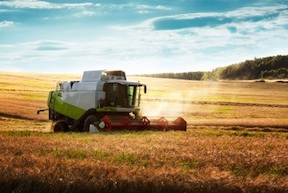 Thanks to technology and smarter farming practices it takes approximately one fifth as much land today to raise the same amount of crop as in 1940.1 Whether it was farmers using new cross pollination techniques 50 years ago or the introduction of GMO seeds more recently, farming technology and innovation has continued to allow the American farmer to produce higher yields with less water, pesticides, fuel, fertilizer and all on fewer acres.
Thanks to technology and smarter farming practices it takes approximately one fifth as much land today to raise the same amount of crop as in 1940.1 Whether it was farmers using new cross pollination techniques 50 years ago or the introduction of GMO seeds more recently, farming technology and innovation has continued to allow the American farmer to produce higher yields with less water, pesticides, fuel, fertilizer and all on fewer acres.
The latest industry looking to disrupt farming with new technology is “Big Data.” The first clever start up to realize the opportunity was Climate Corporation which was founded in 2006 and recently purchased last October by Monsanto (MON) for $1B dollars. “Climate Corporation, founded by two ex-Google employees, has mapped all 25 million fields in America and superimposed it´s database of over 150 billion soil observations and 10 trillion weather simulation points.”2 Monsanto, now the owner of that soil and weather data, aims to combine it with their extensive knowledge and data of seeds to determine which seeds will grow best in which fields and under what weather conditions. By loading seed drills, pivots and other farm machinery with this information and combining it with GPS technology, fields will be able to be “prescriptively planted.” And this rush for a competitive edge is triggering new farming technology:
“Additionally, John Deere and DuPont recently partnered to beam similar information on seeds and fertilizers directly to farmers in their tractors. According to farmers that have tried the Monsanto´s Fieldscript system, they say it has increased yields 5% over two years, a feat no other single invention could match.”3
Using big data to improve farming techniques is still in its infancy, but it could prove to offer powerful benefits to farmers and increased revenues for large Ag companies. Some of the companies out front on this trend are Monsanto (MON), Deere & Company (DE) , and DuPont (DD) and may be poised to be the biggest beneficiaries. In the end, the best investments will be the companies that are able to increase the quantity, quality and sustainability of our food sources.
Lastly, any time large amounts of information are aggregated and analyzed to gain insight or advantage, privacy and ownership issues arise. This occasion is no different. Farmers rightfully fret that their unique farming techniques and knowledge may be sold or copied. They also worry that Monsanto or others may use the data to acquire underperforming farms and compete with them.4 While there are still battles to wage over who owns the data and how it can be shared, it is quite clear that the use of comprehensive data and farming technology to prescriptively plant crops will continue to boost yields on American farms and help feed a growing population in a world with ever fewer and increasingly strained natural resources.
Sources:
- Plant and Soil Survey E Library
- The Economist, May 24th 2014, “Digital Disruption on the Farm”
- The Economist, May 24th 2014, “Digital Disruption on the Farm”
- The Economist, May 24th 2014, “Digital Disruption on the Farm”
No position in any of the mentioned securities at the time of publication. Any opinions expressed herein are solely those of the author, and do not in any way represent the views or opinions of any other person or entity.








